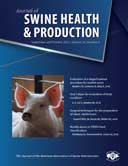Abstract:

Development of effective and minimally invasive surgical techniques for the preparation of intact, sterile boars
Bruna F. V. Superti, DVM; Andressa Pereira de Souza, MSc, Dra; Bruna Carolina Müller, DVM; Zigomar da Silva, MSc, DVM; Eraldo Lourenso Zanella, DVM, MSc, PhD; Ricardo Zanella, DVM, MSc, PhD; Mariana Groke Marques, DVM, MSc, Dra
Complete article is available online.
PDF version is available online.
Objective: The objective of this study was to evaluate three surgical procedures to produce intact, sterile boars.
Materials and methods: Boars (n = 39) were allocated to one of four treatment groups: no surgery (control), epididymectomy by removal of the epididymis tail (TE), vasectomy via scrotal access (VS), and vasectomy via inguinal access (VI) at 63 days of age. Selected physiological, hematological, and endocrine responses were monitored after surgeries to evaluate the different techniques’ relative safety and effectiveness.
Results: Libido and testosterone concentrations were not affected by surgical treatment and were similar to those observed in the control group. The TE and VS procedures required the least and most time to complete, respectively, while VI was intermediate (P < .001). Both lactate and cortisol concentrations were elevated at the time of surgery compared with the control group, but had decreased by 2 days post surgery (P = .02).
Implications: Considering the surgical time and ease, the TE procedure is suggested as the choice technique for producing intact, sterile boars. The swine industry is shifting from individual crates to the use of group pen housing of sows. Use of intact, sterile boars could be implemented to improve estrus detection in group pen housing systems.
Keywords: teaser boar, vasectomy, epididymectomy, estrus detection
![]() Cite as: Superti BFV, de Souza AP, Müller BC, da Silva Z, Zanella EL, Zanella R, Marques MG. Development of effective and minimally invasive surgical techniques for the preparation of intact, sterile boars. J Swine Health Prod 2021;29(5):253-260.
Cite as: Superti BFV, de Souza AP, Müller BC, da Silva Z, Zanella EL, Zanella R, Marques MG. Development of effective and minimally invasive surgical techniques for the preparation of intact, sterile boars. J Swine Health Prod 2021;29(5):253-260.
Search the AASV web site for pages with similar keywords.
